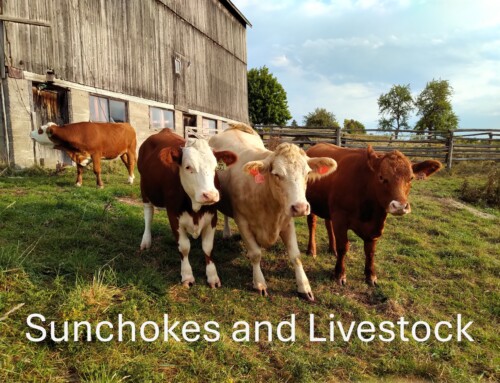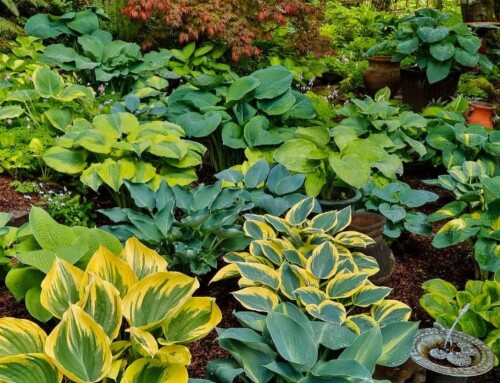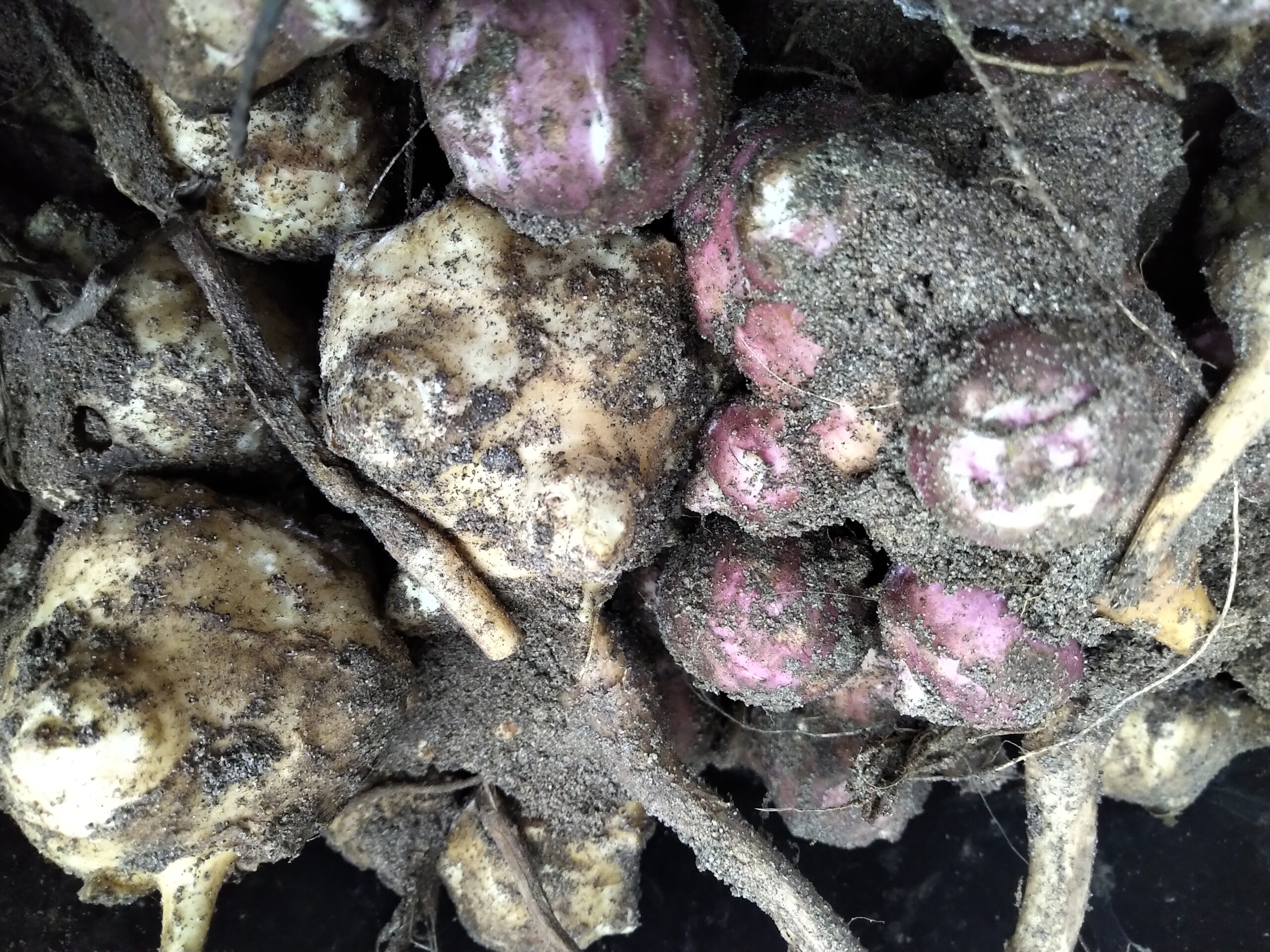
Earth Apples
Native to North America are the wonderful and versatile Sunchokes also known as Jerusalem Artichokes. First written about in 1600’s/1700’s but sure to have been around much earlier. Regardless of their age and name, plants and trees have different names because of the various peoples naming them from different areas. I wonder what the indigenous called them? Well, I will need to ask my Manitoulin neighbour. Gave her some tonight (she is native) and she remembers the elders digging some up. So they have been on Manitoulin Island for a long while.
Once you identify the Sunchoke plant or dig up the earth apples, you know them. You know they are them and can proceed. Their look. Their texture. Their smell and taste. Unique to sunchokes.
My History with Jerusalem Artichokes
For over 20 years, I have purchased Jerusalem Artichokes from my organics guy, Daryl. He introduced them to me on one of our phone calls. Smart guy. Back in the eighties, he delivered organic produce to the grocery stores when they first were trying to get into organics. He sold to health food stores that had perishables and he provided organics to some local Toronto restaurants as well as several good customers. I met Daryl when I ask my health food store for 80 lemons (mid nineties). They connected me with Daryl and until he moved out of the city, I enjoyed our phone conversations on order day (Sundays). Delivery day was every Tuesday and every order came with a hand written list and prices. Always a story or more to share. Isn’t life grand?
Yes they do love the sunshine. 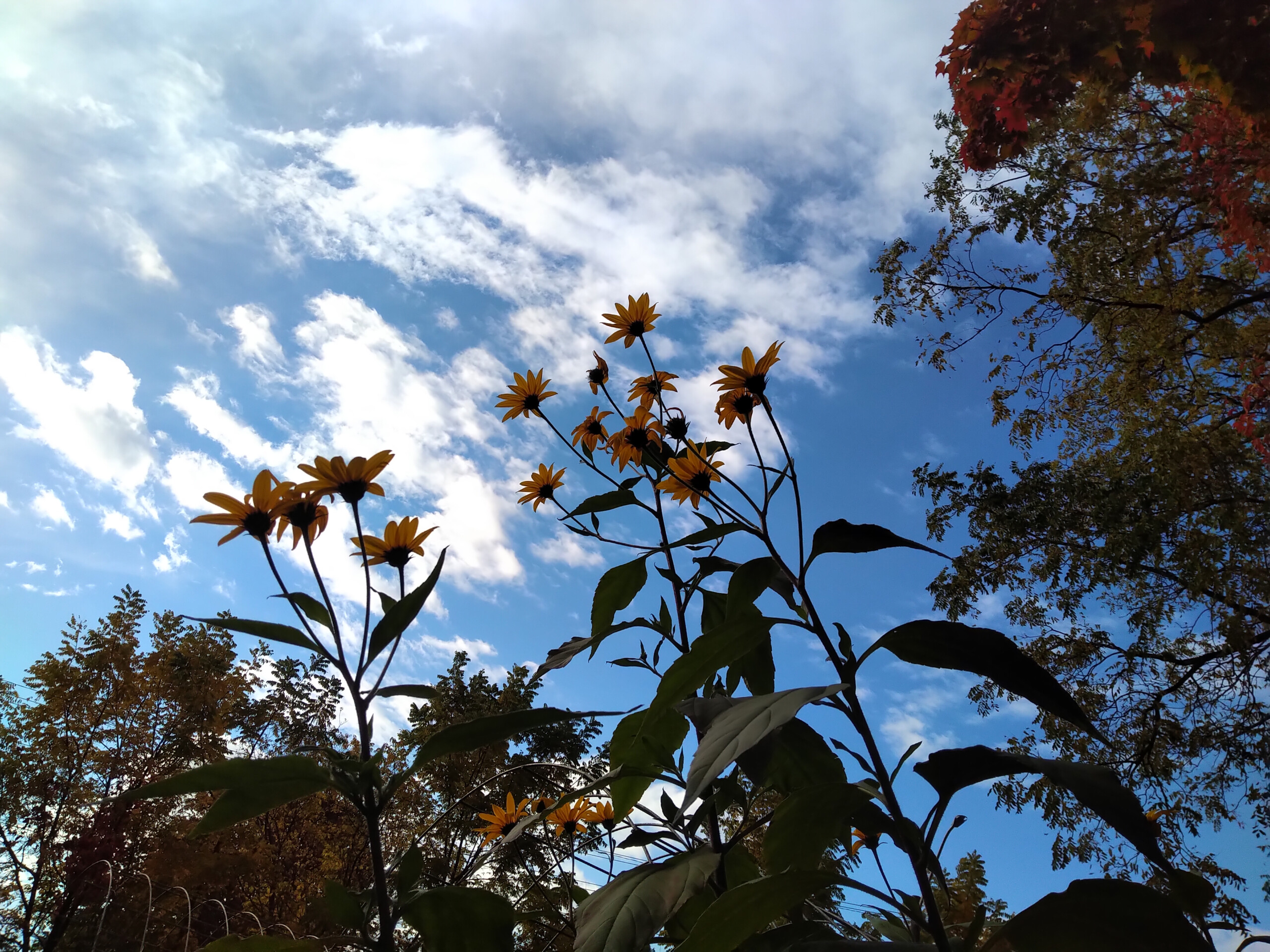
About Sunchokes
The Sunchoke plant is a part of the sunflower family. They grow tall stalks up to 12 feet tall, have fuzzy leaves, and display small yellow flowers in the Fall that look like sunflowers. Sunchokes are a perennial root vegetable similar to potatoes (nightshades) but not. This plant is hardy and grows in cold climates. For two years, I grew them at my dad’s home, Thornton, Ontario and then in 2024 on Manitoulin Island, Ontario. This year I held a class to share the wonders of this plant from tasting, growing, and harvesting. Participants took some home to eat and to plant.
The most lovable part of growing sunchokes is they will grow in many different climates and soil conditions. This and their taste (cooked or raw) makes them a great survival food. Ideal for survivalists and homesteaders who have livestock.
Sunchoke Benefits
- a source of inulin which is a prebiotic and undigestible fiber that feeds the good bacteria in our gut
- as a result of a healthy microbiome/digestive system, it potentially helps with improved immunity, slows down blood sugar levels (diabetes), and cardiovascular health
- a source of antioxidants which protects us from the oxidative stress
- a rich source of sugars which may help in bone health by absorbing minerals such as calcium and magnesium
- a good source of potassium so next to eating bananas, sunchokes is another option to improve blood pressure
- a good source of iron which is ideal for making red blood cells and our energy levels
There is most likely more well-being benefits that can be shared some of which would be discovered if more research was allocated – similar to many other plants, fruits, and vegetables.
Planting
Sunchokes are planted in the Spring. Plant mid to late April or early May. When they are harvested, you can easily miss some just like potatoes. They will shoot up as soon as they are ready. I hear sunchokes are hard to get rid of once you plant them and to not plant them in your usual garden. This will depend on how you harvest and if you do miss some, cut off the greens when you see some shooting up or do like I did, I dug them up and moved them to the other side of the garden.
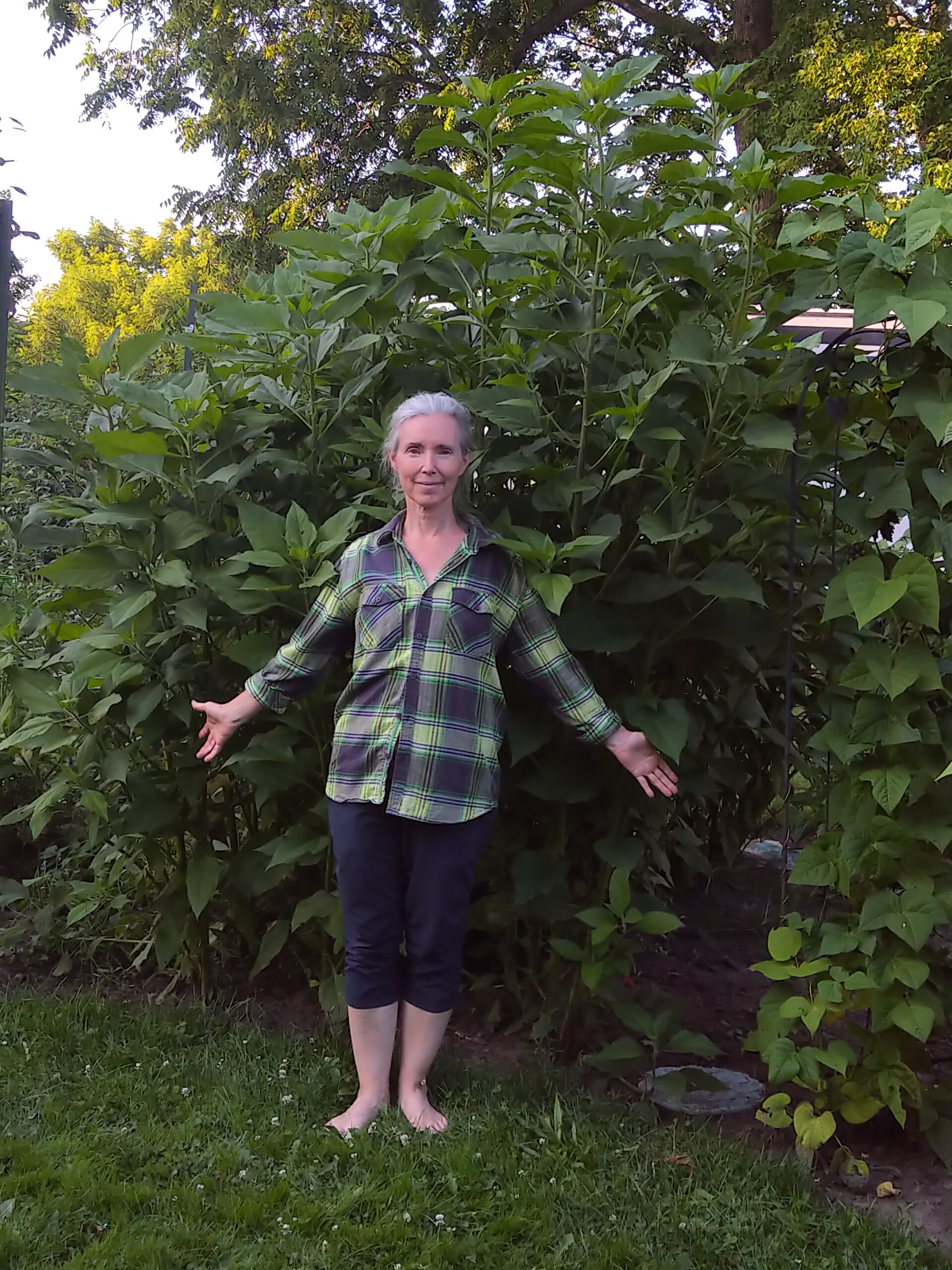
2023 Thornton Garden – Cheryl and Sunchokes
Harvesting
This part is fun. All hands in dirt! First decide on the timing. Harvesting sunchokes can take place early Spring like April then you save some to replant or do it right away if planting in the same spot. This is what I did and sunchokes were only available to buy in Mar/Apr/May. In my research, I learned that most people harvested them in the Fall, hopefully after a frost to two or three (perhaps less wind/farting that way).
I experimented at my dad’s. I dug up one plant (had eight) every month from October through April, unthaw them in a bowl and they were fresh as a daisy. I noticed in April that some were beginning to seed already. Some people experienced wind while I don’t remember this happening to me.
With a spade fork or shovel, you loosen the dirt about one foot out from the stalk (keep the stalk in the ground either a foot or full height so you know where they are). They will be near the stalk, near the top, down 10 inches or even further out than a foot. Wonderful to find the big ones. Looks like ginger yet something more.
Storaging Sunchokes
I stored mine in the cupboard for a few days, then in the fridge. In both cases, they were in paper bags. Figure out what works for you. They do get limp out of the fridge but they can also get moldy in the fridge if they are not breathing. If there was moisture showing on the bag, I would put the bag on the counter until they dried up.
You could freeze them although I prefer to harvest and eat while they are in season. Some have said they put sunchokes in Kimchi while others ferment them.
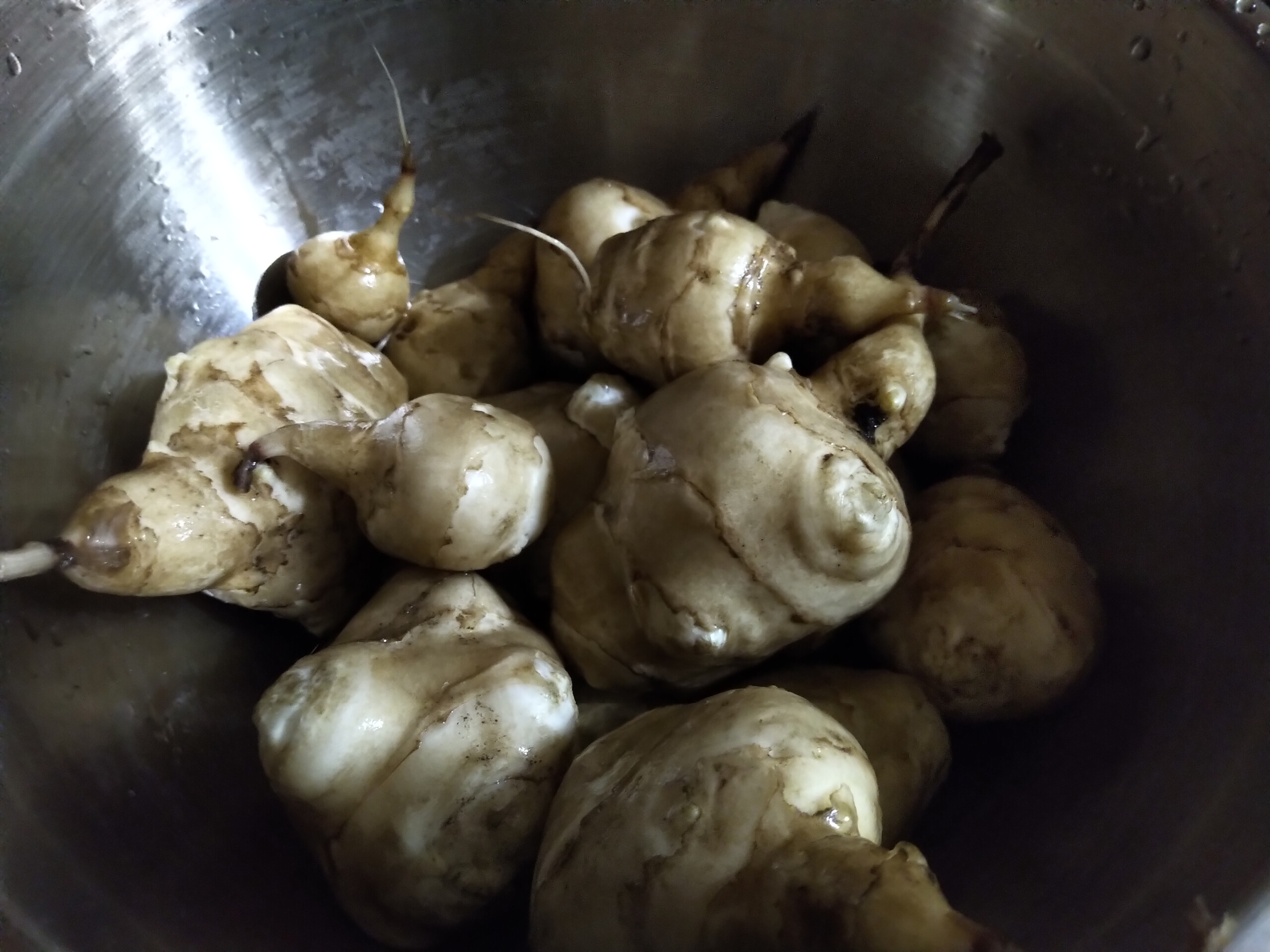
Sunchokes Washed and Ready to Cut/Cook
Eating Sunchokes
Either raw or cooked, usually mashed, is my go to ways. For the first time, I double boiled them to see if it would take away some of the wind (nope). Some put them in soups and stews. This year, I fried up my leftover mashed sunchokes until crispy. Prepare as you wish. However you use potatoes, you can substitute with sunchokes. There is a different taste so experiment AND start off with a small amount so you gut can get use to them. Remember the wind!
Do look for sunchokes in your local farmer’s market or better yet, grow them if you have room.
Stay tuned for a blog on Sunchokes and Livestock.




